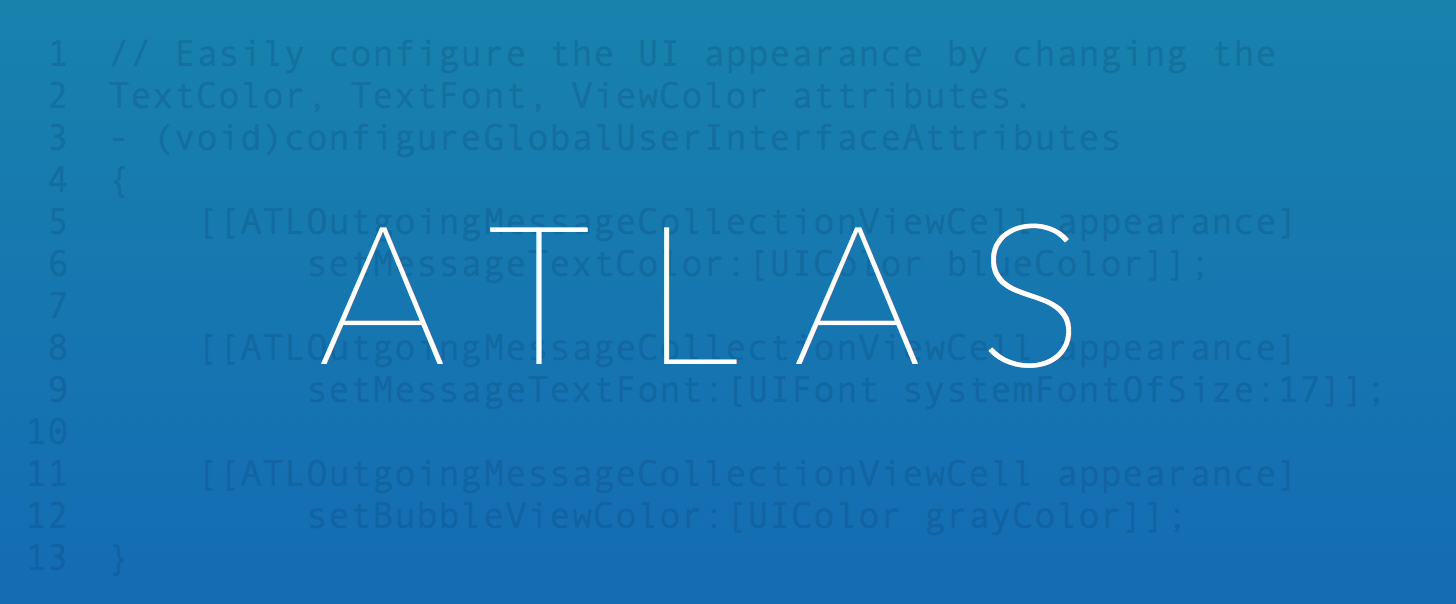This repository contains the source code of Atlas Messenger, an example application built by Layer to showcase the capabilities of Atlas, a library of robust communications user interface components integrated with the Layer platform.
Building Atlas Messenger requires that you obtain a Layer App ID. You can obtain an App ID by registering for a Layer account on the Experience Atlas page. Alternately, a pre-built version is available for immediate testing at the same location.
To build Atlas Messenger, you need a few a few standard iOS Development Tools:
- Xcode - Apple's suite of iOS and OS X development tools. Available on the App Store.
- CocoaPods - The dependency manager for Cocoa projects. CocoaPods is used to automate the build and configuration of Atlas Messenger. Available by executing
$ sudo gem install cocoapodsin your terminal.
NOTE: At this time there is a known incompatibility with CocoaPods v0.36.0.beta.2. Please stick to v0.35.0 or v0.36.0.beta.1 instead.
Once you have installed the prerequisites, you can proceed with cloning and configuring the project by executing the following commands in your terminal:
$ git clone https://github.com/layerhq/Atlas-Messenger-iOS.git
$ cd Atlas-Messenger-iOS
$ pod installThese commands will clone Atlas Messenger from Github, configure the Atlas submodule in the Libraries sub-directory, and then install all library dependencies via CocoaPods. Once these steps have completed without error, you can open the workspace by executing:
$ open "Atlas Messenger.xcworkspace"Before running Atlas Messenger from source code you must configure the Layer App ID. To do so, switch to the Project Navigator by selecting the View menu > Navigators > Show Project Navigator (or type ⌘1) and expand the items Atlas Messenger and Code. Tap on ATLMAppDelegate.m to open the application delegate code and locate the following code near the top of the file:
// TODO: Configure a Layer appID from https://developer.layer.com/dashboard
static NSString *const ATLMLayerAppID = nil;Replace the nil with the appID you previously obtained from the Atlas build page. Be sure to enclose it in standard Objective-C string quotes (@""). Once configured your code should now look something like:
static NSString *const ATLMLayerAppID = @"035c3b96-ecb5-4642-b6b1-ff49ea2dd5db";Note: The current Atlas Messenger project is designed to only work with a special Atlas Messenger project. To create this special App ID you must go to the Atlas build page. If you use a different App ID you will see a "Request failed: forbidden" error when you launch the app.
You can now proceed with building and running Atlas Messenger. Select Run from the Product menu (or type ⌘R). After the build completes, Atlas Messenger will launch launch in your iOS Simulator.
Atlas Messenger was designed to strike a balance between being simple enough to quickly peruse the project, but full-featured enough to fully demonstrate the power of Atlas and Layer. As you begin working with the example code, keep the following things in mind:
- Layer is a hosted communications platform. All communications services leveraged by Atlas Messenger utilize the backend services hosted by Layer.
- LayerKit is the native iOS SDK for accessing the Layer communications platform. LayerKit handles the networking, persistence, security and synchronization necessary to implement robust native messaging. LayerKit also presents a programming model for accessing the Conversations and Messages that are transmitted through Layer.
- Atlas is a library of user interface components developed by Layer that provide fully integrated user interface experiences on top of LayerKit. Atlas has a direct dependency on LayerKit and is not usable standalone.
When working with the Atlas Messenger codebase you will encounter code coming from LayerKit (prefixed by LYR), Atlas (prefixed by ATL), and Atlas Messenger itself (prefixed by ATLM).
The project is organized as detailed in the table below:
| Path | Type | Contains |
|---|---|---|
Code |
Directory | Source code organized by type |
Gemfile |
Ruby code | Ruby Gem dependency declarations for Bundler |
Gemfile.lock |
ASCII text | Exact Gem dependency manifest (generated by Bundler) |
LICENSE |
ASCII text | Licensing details for the project |
Libraries |
Directory | Submodules and external project dependencies |
Podfile |
Ruby code | CocoaPods library dependencies for the project |
Podfile.lock |
ASCII text | Exact Pod dependency manifest (generated by CocoaPods) |
Pods |
Directory | CocoaPods generated artifacts. Ignored by Git. |
README.md |
Markdown text | This comprehensive README file |
Rakefile |
Ruby source | Rake automation tasks |
Resources |
Directory | Assets such images |
Atlas Messenger.xcodeproj |
Xcode Project | The Xcode project for Atlas Messenger. Use the workspace instead. |
Atlas Messenger.xcworkspace |
Xcode Workspace | The Xcode workspace for Atlas Messenger. Used for day to day development. |
Tests |
Directory | Test code for the application. |
.ruby-version |
rbenv configuration | Specifies the version of Ruby that rbenv will bind to |
xcodebuild.log |
Log file | Log out xcodebuild output generated by test Rake tasks. Under .gitignore |
Because Atlas Messenger is designed to showcase the capabilities of Atlas, most of the interesting code lives in Code/Controllers and Code/Views.
Atlas Messenger is licensed under the terms of the Apache License, version 2.0. Please see the LICENSE file for full details.
Atlas Messenger was developed in San Francisco by the Layer team. If you have any technical questions or concerns about this project feel free to reach out to Layer Support.
